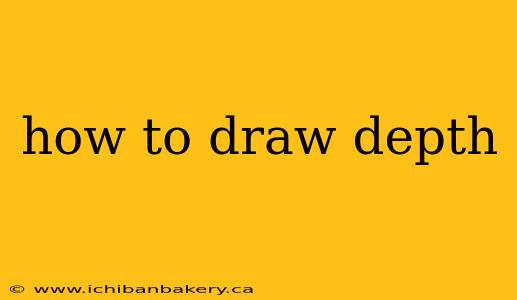Creating the illusion of depth on a flat surface is a fundamental skill in drawing and painting. This article will guide you through various techniques to master depth perception and add realism to your artwork. Understanding how to draw depth will significantly enhance the impact and believability of your drawings.
Understanding Perspective: The Foundation of Depth
Perspective is the art of creating the illusion of three-dimensional space on a two-dimensional surface. It's the cornerstone of depicting depth accurately. There are three main types of perspective:
1. One-Point Perspective
One-point perspective uses a single vanishing point on the horizon line. All parallel lines converge towards this point. This is ideal for drawing simple scenes, like roads or buildings viewed from the front.
- How to Use It: Choose a vanishing point on your horizon line. Draw lines from your subject's edges towards this point to create the sense of depth. Objects further away will appear smaller.
2. Two-Point Perspective
Two-point perspective uses two vanishing points on the horizon line. This technique is more complex but allows for more dynamic compositions, particularly for scenes with objects viewed from a corner.
- How to Use It: Establish two vanishing points on your horizon line. Draw lines from the corners of your subject to both vanishing points. The further away an object is, the smaller and more compressed it will appear.
3. Three-Point Perspective
Three-point perspective adds a third vanishing point either above or below the horizon line. This creates the effect of looking up at tall buildings or down from a height. It adds a sense of dramatic height or depth.
- How to Use It: Add a third vanishing point, either above (for a "worm's-eye" view) or below (for a "bird's-eye" view) the horizon line. Use this point in conjunction with your two-horizon points to guide your lines.
Beyond Perspective: Enhancing Depth with Other Techniques
While perspective forms the basis of depth, several other techniques can significantly enhance the illusion of three-dimensionality.
Atmospheric Perspective
Atmospheric perspective simulates the effect of the atmosphere on distant objects. As objects recede into the background, they appear less distinct and their colors become paler and cooler.
- How to Use It: Gradually reduce the contrast and intensity of colors as objects move further away. Add a slight haze or blur to distant elements.
Overlapping and Size Variation
Overlapping objects and varying their size create a natural sense of depth. Objects closer to the viewer will appear larger and overlay those in the background.
- How to Use It: Carefully arrange objects so they partially obscure one another. Ensure closer objects are larger than those further away.
Value and Light
Light and shadow play a crucial role in suggesting depth. Proper use of values creates a three-dimensional form, highlighting form and volume.
- How to Use It: Employ a range of values from dark to light to model your objects. Pay attention to the direction and intensity of the light source.
Detail and Texture
Closer objects usually exhibit more detail and texture than those further away. This difference in detail enhances depth perception.
- How to Use It: Include fine details and textures in the foreground. Gradually reduce the amount of detail in the background.
How to Draw Depth: A Step-by-Step Example (One-Point Perspective)
Let's draw a simple road receding into the distance using one-point perspective.
- Establish the Horizon Line: Draw a horizontal line across your page. This represents the eye level.
- Choose a Vanishing Point: Select a point on the horizon line. This is where all parallel lines will converge.
- Draw the Road: Draw two lines from the bottom of your page towards the vanishing point. These form the sides of the road.
- Add Details: Add elements like trees, houses, or cars. Remember to reduce their size and detail as they approach the vanishing point.
- Refine and Shade: Add shading and highlights to give your road and objects volume and depth.
Mastering Depth: Practice and Patience
Drawing depth is a skill that develops with practice. Don't be discouraged if your first attempts aren't perfect. Experiment with different perspectives, techniques, and subjects. The more you practice, the better you will become at creating believable and engaging artwork with convincing depth. Remember to study the work of master artists to learn how they use these techniques in their own artwork. Observe the world around you, paying close attention to how perspective and other elements contribute to the illusion of depth. With dedication and practice, you will master the art of drawing depth and significantly enhance your artistic skills.
